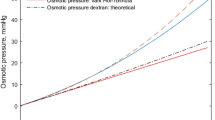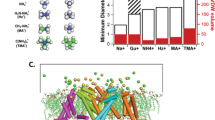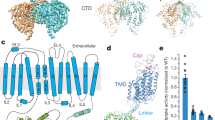Abstract
PARKER and Snow1 have shown that extracellular ATP produces an apparently nonspecific and reversible increase in the cation (Na+ and K+) permeability of dog red cells, as a result of which the cells swell gradually during suspension in an isosmolar physiological bathing medium containing ATP. This effect contrasts markedly with the usual dependence on cell volume of cation fluxes in this type of red cell2–6 which, unlike most mammalian erythrocytes, is close to ionic equilibrium with plasma6–7, and lacks an ouabain-sensitive ion pump8,9. Exogenous ATP was found to influence the surface properties of chick embryo fibroblasts10, and also cause volume changes and cation imbalances in ascites tumour cells11, and it has been suggested11 that ATP alters the passive permeability of the membrane to Na+ and K+ rather than the cation pumping mechanism per se. Effects of ATP on the membrane transport characteristics of various tissue culture cell lines have been studied12,13, and it has been proposed12 that the translocation of ATP itself may be linked with ion movement across membranes.
This is a preview of subscription content, access via your institution
Access options
Subscribe to this journal
Receive 51 print issues and online access
$199.00 per year
only $3.90 per issue
Buy this article
- Purchase on Springer Link
- Instant access to full article PDF
Prices may be subject to local taxes which are calculated during checkout
Similar content being viewed by others
References
Parker, J. C., and Snow, R. L., Am. J. Physiol., 223, 223–888 (1972).
Davson, H., J. Physiol., Lond., 101, 265 (1942).
Hoffman, J. F., Am. J. Med., 41, 666 (1966).
Romualdez, A., Sha'afi, R. I., Lange, Y., and Solomon, A. K. J. gen. Physiol., 60, 46 (1972).
Elford, B. C., and Solomon, A. K., Biochim. biophys. Acta, 373, 253 (1974).
Elford, B. C., J. Physiol., Lond., 246, 371 (1975).
Berstein, R. E., Science, 120, 459 (1954).
Chan, P. C., Calabrese, V., and Theil, L. S., Biochim. biophys. Acta, 79, 424 (1964).
Miles, P. R., and Lee, P., J. Cell Physiol., 79, 367 (1972).
Jones, B. M., Nature, 212, 362 (1966).
Hempling, H. G., Stewart, C. C., and Gasic, G., J. Cell Physiol., 73, 133 (1969).
Trams, E. G., Nature, 252, 480 (1974).
Aiton, J. F., and Lamb, J. F., J. Physiol., Lond., 248, 14P (1975).
Elford, B. C., and Solomon, A. K., Nature, 248, 522 (1974).
Khan, M. M. T., and Martell, A. E., J. Am. chem. Soc., 88, 668 (1966).
Caldwell, P. C., in Calcium and Cellular Function (edit. by Cuthbert, A. W.), (Macmillan, London, 1970).
Davson, H., and Reiner, J. M., J. cell comp. Physiol., 20, 325 (1942).
Sha'afi, R., and Pascoe, E., J. gen Physiol., 61, 709 (1973).
Hille, B., Progr. Biophys., 21, 3 (1970).
Author information
Authors and Affiliations
Rights and permissions
About this article
Cite this article
ELFORD, B. Independent routes for Na transport across dog red cell membranes. Nature 256, 580–582 (1975). https://doi.org/10.1038/256580a0
Received:
Accepted:
Issue Date:
DOI: https://doi.org/10.1038/256580a0
This article is cited by
-
Permeabilization of transformed cells in culture by external ATP
The Journal of Membrane Biology (1985)
Comments
By submitting a comment you agree to abide by our Terms and Community Guidelines. If you find something abusive or that does not comply with our terms or guidelines please flag it as inappropriate.



